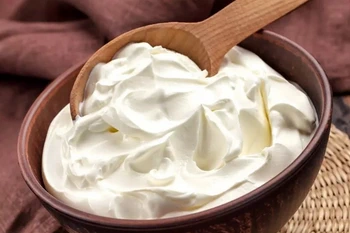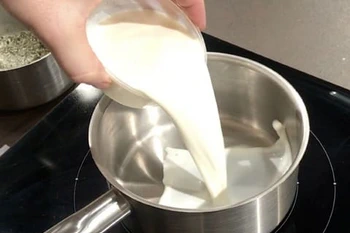This site uses only a few technical cookies necessary for its operation. By continuing to browse, you accept their use.
To find out more...
To find out more...
The little trap of thick cream

When you need to add cream to a recipe, you might be wondering: thick (heavy) cream or liquid cream?
In most cases, there's no big difference: you can use either.
But there is one exception, and that's when the cream needs to be cooked, for a sauce for example, and here the difference between liquid and thick cream is important.
Let's find out why.
In most cases, there's no big difference: you can use either.
But there is one exception, and that's when the cream needs to be cooked, for a sauce for example, and here the difference between liquid and thick cream is important.
Let's find out why.
7,380 5/5 (1 reviews)
Keywords for this post:CreamThickHeavyTextureLiquidFoilSauceBindingTrapLast modified on: December 13th 2024
The little trap of thick cream
The differences between them

Liquid cream: Naturally fluid, with a fat content generally around 30-35%.
It is homogenized, meaning that the fat particles are evenly distributed in the liquid.
This structure makes it stable to cooking: it incorporates easily without breaking down.

Thick cream: In addition to fat (similar to liquid cream), it often contains lactic ferments, which give it its tangy taste and denser consistency.
These ferments slightly modify the structure of the proteins.
Cooking behavior
Liquid cream: It retains its fluid texture when heated, as it does not contain the lactic ferments that could interact with heat.It is ideal for sauces, gratins or dishes requiring a stable emulsion.
Thick cream: When cooked, heat can break down the interactions between proteins and fats stabilized by lactic ferments.
This releases the water contained in the cream, giving it a runnier consistency.
The little trap
It's this cooking behavior of thick cream that's a bit of a trap: when you're looking for a thick sauce texture, you naturally think of using thick cream, but that's a mistake, as it will liquefy very quickly.Contrary to its name, thick cream doesn't thicken, quite the opposite, so it's best avoided for thick sauces and preparations.
Don't worry either, both will cook well, but if you're looking for a slightly thicker texture, not too liquid, you'll have to go for the liquid cream.
To sum up: if you want a thick texture in a recipe with cream, especially a sauce, use liquid cream, not thick cream.
Lasts posts
Butter vs. grease
We often read in a recipe where a pastry is put into a mould that, just before pouring, the mould should be buttered or greased. But what's the difference between these 2 terms?December 1st 20258265
Getting out of the fridge early
Very often when you're cooking, you need to take food or preparations out of the fridge, to use them in the recipe in progress. There's nothing tricky about this: you just take them out of the fridge and use them, usually immediately, in the recipe. But is this really a good method?November 24th 20251,0265
Who's making the croissants?
When you look at a bakery from the outside, you naturally think that in the bakery, the bakers make the bread, and in the laboratory, the pastry chefs make the cakes. It's very often like that, with each of these professions having quite different ways of working, but sometimes there's also one...November 23th 2025924
Oven height
When we put a dish or cake in the oven, we naturally tend to put it on the middle shelf, and that's what we usually do. But in some cases, this position and height can be a little tricky, so let's find out why.October 8th 20252,5585
The importance of sieving
In recipes that use a fine powder (flour, powdered sugar, etc.), you'll often see the advice to sift before using it. To sift is to pass the powder in question through a sieve (a very fine strainer) before incorporating it into your recipe. It's often advice, but is it really useful?September 3rd 20257,4173
Other pages you may also like
What is the difference between bakery and patisserie?
This is a question that you may well have asked yourself and which I will attempt to answer. In France the two trades of "boulangerie" (bakery) and "pâtisserie" (patisserie and confectionery) have always been quite distinct, but where exactly do the boundaries lie? .February 7th 2017134 K 14.1
Candied fruits: don't get ripped off
Do you like candied fruit? You might like to nibble a handful or add it to a recipe, like a classic fruit cake or delicious Italian specialities like panettone or sicilian epiphany pie.June 21th 201767 K 24.2
How to avoid lumps
You've probably come across this unpleasant phenomenon where, when you try to incorporate an ingredient (usually a solid or powder) into a preparation (usually a liquid), the mixture doesn't mix properly and you end up with little "balls" or little lumps of the solid part that refuse to mix with the...October 9th 202022 K4.8
A few tips for effective kneading at home
When you have to knead dough for bread or some other recipe, you may well use a food processor or the type of machine known as a stand mixer. The best-known brands are Kenwood and KitchenAid. They are useful tools, but here are a few tips to help you get the best out of them.June 23th 2021283 K 23.8
Egg yolks and caster sugar
We often come across recipes where we need to mix egg yolks with caster sugar. This would appear to be a very ordinary and simple thing to do but, be warned, these two ingredients can behave oddly together.February 15th 201882 K 24.3
Post a comment or question
Follow this page
If you are interested in this page, you can "follow" it, by entering your email address here. You will then receive a notification immediately each time the page is modified or a new comment is added. Please note that you will need to confirm this following.
Note: We'll never share your e-mail address with anyone else.
Alternatively: you can subscribe to the mailing list of cooling-ez.com , you will receive a e-mail for each new recipe published on the site.









